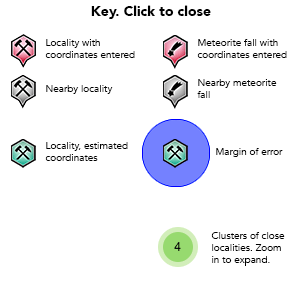Hangover Bore Ni prospect, Ten Mile Outcamp, Leonora Shire, Western Australia, Australia

| Latitude & Longitude (WGS84): | 28° 18' 27'' South , 120° 59' 19'' East |
|---|---|
| Latitude & Longitude (decimal): | -28.30752,120.98886 |
| GeoHash: | G#: qdyncnv2s |
| Locality type: | Prospect |
| Köppen climate type: | BWh : Hot deserts climate |
The Hangover Bore Ni prospect is 15 kilometres north north-east of the Mount Clifford Ni prospect, in the Marshall Pool area. These are two of several uneconomic Ni prospects in the area. Hangover Bore is a large but low grade Ni-Co laterite deposit blanketing an adcumulate body.
The deposit is located in the Hangover Bore Syncline. The core of the syncline is a sequence of thin differentiated komatiite flow lodes, and high Mg basalts, with extremely well preserved igneous textures. Thinner komatiite flows (2-5 metres) exhibit a variety of spinifex textures, whereas the thicker flows are olivine orthocumulate.
Unlike Mt Clifford, there is no gabbro between the upper spinifex flows, and underlying olivine adcumulate. There is no outcropping at Hangover Bore, despite the deposit being near surface. The adcumulate is 500 metres thick. At the base of the east side it is in contact with thin sheared chloritic sediment. At the base of the west side is a zone of spinifex textured rocks.
The marginal zone of the east limb is 50 metres thick. The lower 20 metres of this shows thin amphibolite-chlorite grading into olivine orthocumulate with oikocrystic crystals and edenite. (Oikocrystic- a poikilitic texture is which small randomly orientated crystals are enclosed within larger crystals of another mineral. The smaller enclosed crystals are known as chadacrysts, and larger crystals oikocrysts. Edenite is part of the amphibole group.)
The zone above this contains oikocrysts of Cr rich magnesian-augite, enclosing serpentinized olivine, grading upwards into modal olivine, then very coarse pure olivine adcumulate at 50 metres above the base.
Mineral List
2 valid minerals.
Rock Types Recorded
Select Rock List Type
Alphabetical List Tree DiagramRegional Geology
This geological map and associated information on rock units at or nearby to the coordinates given for this locality is based on relatively small scale geological maps provided by various national Geological Surveys. This does not necessarily represent the complete geology at this locality but it gives a background for the region in which it is found.
Click on geological units on the map for more information. Click here to view full-screen map on Macrostrat.org
| Cenozoic 0 - 66 Ma ID: 794950 | ferruginous duricrust 38498 Age: Cenozoic (0 - 66 Ma) Description: Ferruginous duricrust, laterite; pisolitic, nodular, vuggy; may include massive to pisolitic ferruginous subsoil, mottled clays, magnesite, reworked products of ferruginous and siliceous duricrusts, calcrete, gossan; residual ferruginous saprolite Comments: regolith; synthesis of multiple published descriptions Lithology: Regolith Reference: Raymond, O.L., Liu, S., Gallagher, R., Zhang, W., Highet, L.M. Surface Geology of Australia 1:1 million scale dataset 2012 edition. Commonwealth of Australia (Geoscience Australia). [5] |
| Neoarchean - Mesoarchean 2500 - 3200 Ma ID: 3188638 | Archean volcanic and intrusive rocks Age: Archean (2500 - 3200 Ma) Comments: Yilgarn Craton Lithology: Greenstone belt; mafic-ultramafic volcanic rocks Reference: Chorlton, L.B. Generalized geology of the world: bedrock domains and major faults in GIS format: a small-scale world geology map with an extended geological attribute database. doi: 10.4095/223767. Geological Survey of Canada, Open File 5529. [154] |
Data and map coding provided by Macrostrat.org, used under Creative Commons Attribution 4.0 License



